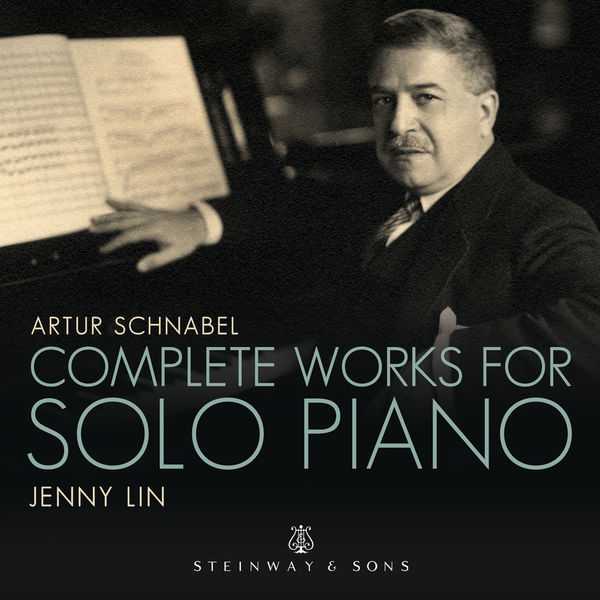

Composer: Artur Schnabel
Performer: Jenny Lin
Format: FLAC (tracks)
Label: Steinway & Sons
Catalogue: STNS30074
Release: 2019
Size: 3.88 GB
Recovery: +3%
Scan: yes
CD 01
3 Fantasy Pieces
01. No. 1, Capriccio “Diabolique”
02. No. 2, Rêverie “Douce tristesse”
03. No. 3, Valse mignonne
3 Piano Pieces, Op. 15
04. No. 1, Rhapsodie
05. No. 2, Nachtbild
06. No. 3a, Walzer. Sehr lebhaft
07. No. 3b, Walzer. Nicht zu rasch
08. No. 3c, Walzer. Nicht rasch
09. No. 3d, Walzer. Mit großem Schwung, sehr flottes Walzertempo
Dance Suite
10. I. Foxtrot (Encounter)
11. II. First Pause (Wooing)
12. III. Waltz (Contact)
13. IV. Second Pause (Floating)
14. V. Towards Tomorrow (Affirmation)
CD 02
Piano Sonata
01. I. Passionate, Intense & Very Resolute – Very Free, Not Fast at All, Always Rather Restrained, but Still Melodious
02. II. Extremely Tender & Simple – Very Quiet, Soft, Sweetly Lost in Thought, Altogether Free
03. III. Cheerful, Impish, Cheeky, Somewhat Obstinate
04. IV. Very Slow, Dreamily, Immersed in Contemplation, Unearthly
05. V. Fiery, Bold, Unrelenting, but Also Without Haste or Excitement, Very Robust
Piece in 7 Movements
06. I. Moderato e semplice
07. II. Vivace un poco resoluto – III. Allegretto piacevole
08. IV. Allegretto agitato
09. V. Vivacissimo
10. VI. Adagio
11. VII. Moderato e semplice
7 Piano Pieces
12. No. 1, Largo
13. No. 2, Allegretto
14. No. 3, Andantino
15. No. 4, Agitato, vivace
16. No. 5, Lento
17. No. 6, Vivace
18. No. 7, Epilogue. Comodo allegretto sereno
4 Waltzes from Old Vienna
19. No. 1 (After J. Strauss’ Opp. 258 & 44)
20. No. 2 (After J. Strauss’ Op. 277)
21. No. 3 (After J. Strauss’ Op. 96)
22. No. 4 (After J. Strauss’ Opp. 277 & 71)
The great Beethoven interpreter Artur Schnabel, like many of his pianistic predecessors but few of his successors, was also a composer. He wrote music in many genres, including three symphonies. His string quartets have been recorded from time to time, but this may be the first survey of his piano music. Pianist Jenny Lin does well to identify this lacuna, for arguably Schnabel’s piano music reflects his personality as a performer better than does his music in other genres. It has a combination of down-to-earth rhythmic sense, seeming spontaneity (aptly described by annotator James Irsay as “a spontaneity that was the result of long and meticulous planning”), and considerable complexity of thought. The works span Schnabel’s life: from his teenage years in the Three Fantasy Pieces of 1898 to the Seven Piano Pieces of 1947, four years before Schnabel’s death. Naturally enough, they range from late Romantic styles at the beginning to near 12-tone music (his procedures are never strict) in the later works; the Seven Piano Pieces are miniatures that show the influence of Webern. The music is much better than might be indicated by the comment of Toscanini when he met Schnabel: “Are you really the same Schnabel who wrote that horrible music I heard ten years ago in Venice?” It may not be quite on the level Irsay’s cheerleading would indicate (contemporary reviewers, who certainly knew their Schoenberg, were mixed), but it is attractively evocative. Sample the five-movement Dance Suite, which, although quite dissonant, convincingly depicts a developing romance between two of Schnabel’s (eventually married) friends. The central waltz spills over its boundaries and goes on for 14 and a half minutes as it embodies the point where things really got cooking. Lin is a fine pianist technically, and she grasps the thread of personality connecting these works. With beautiful sound from Steinway Hall in New York, this is a recommended release, especially for Schnabel fans.
The music is presented chronologically, beginning with Three Fantasy Pieces (1898), written when Schnabel was a teenage student of Theodor Leschetizky…By the 1920s, Schnabel’s compositional style was undergoing radical development. His one and only Piano Sonata (1923), which opens the second disc, is monumental in scope…The Seven Piano Pieces (1947) Schnabel is at ease with atonality; in Lin’s hands the listener is, too.
Lin’s artistry is informed by a curiosity as voracious as it is insatiable. She is also a pianist of the first calibre, with a rock-solid, multivalent technique that serves a richly cultivated imagination. Who knows. She may be just the person to rescue Schnabel’s piano music from the obscurity in which it has languished, virtually since its creation.